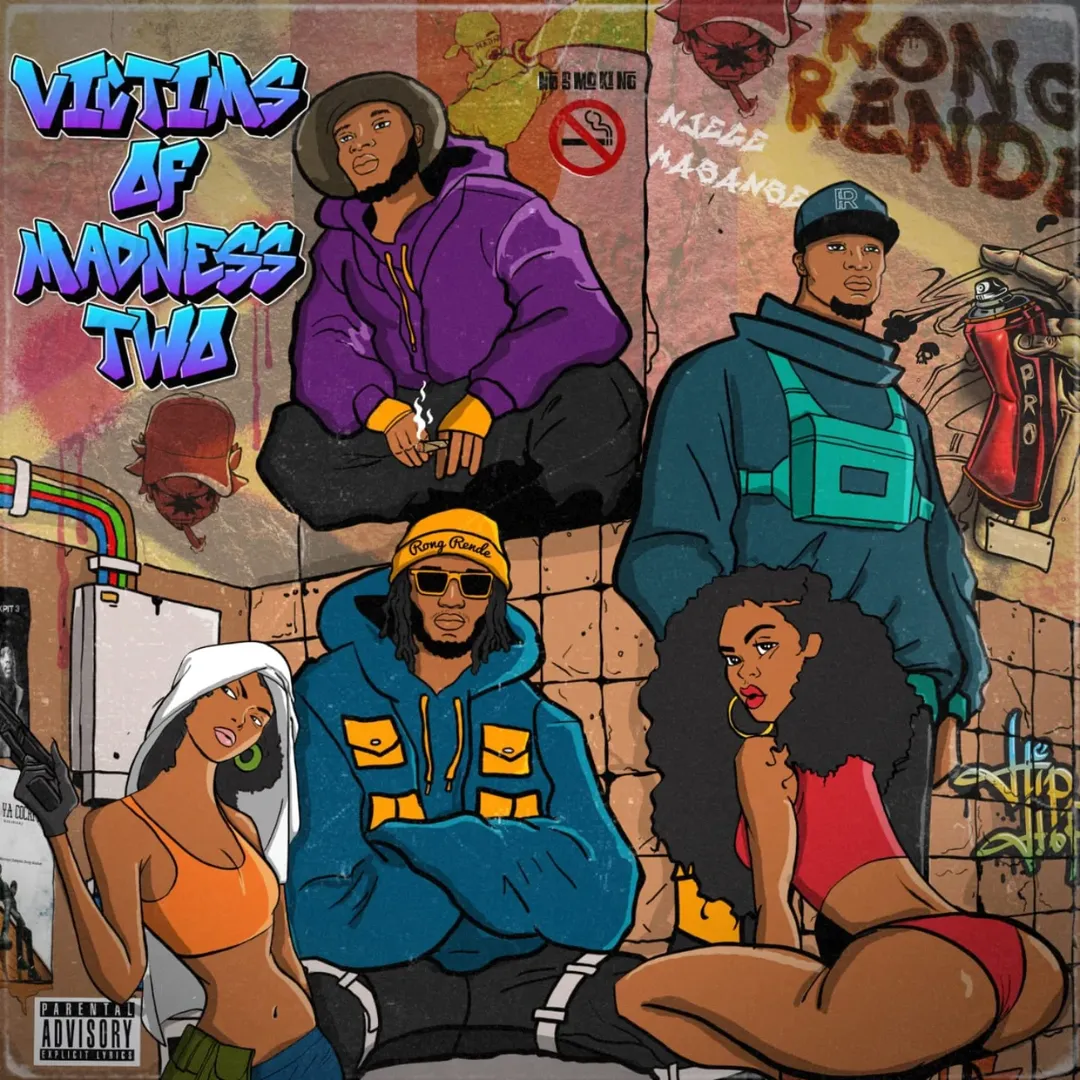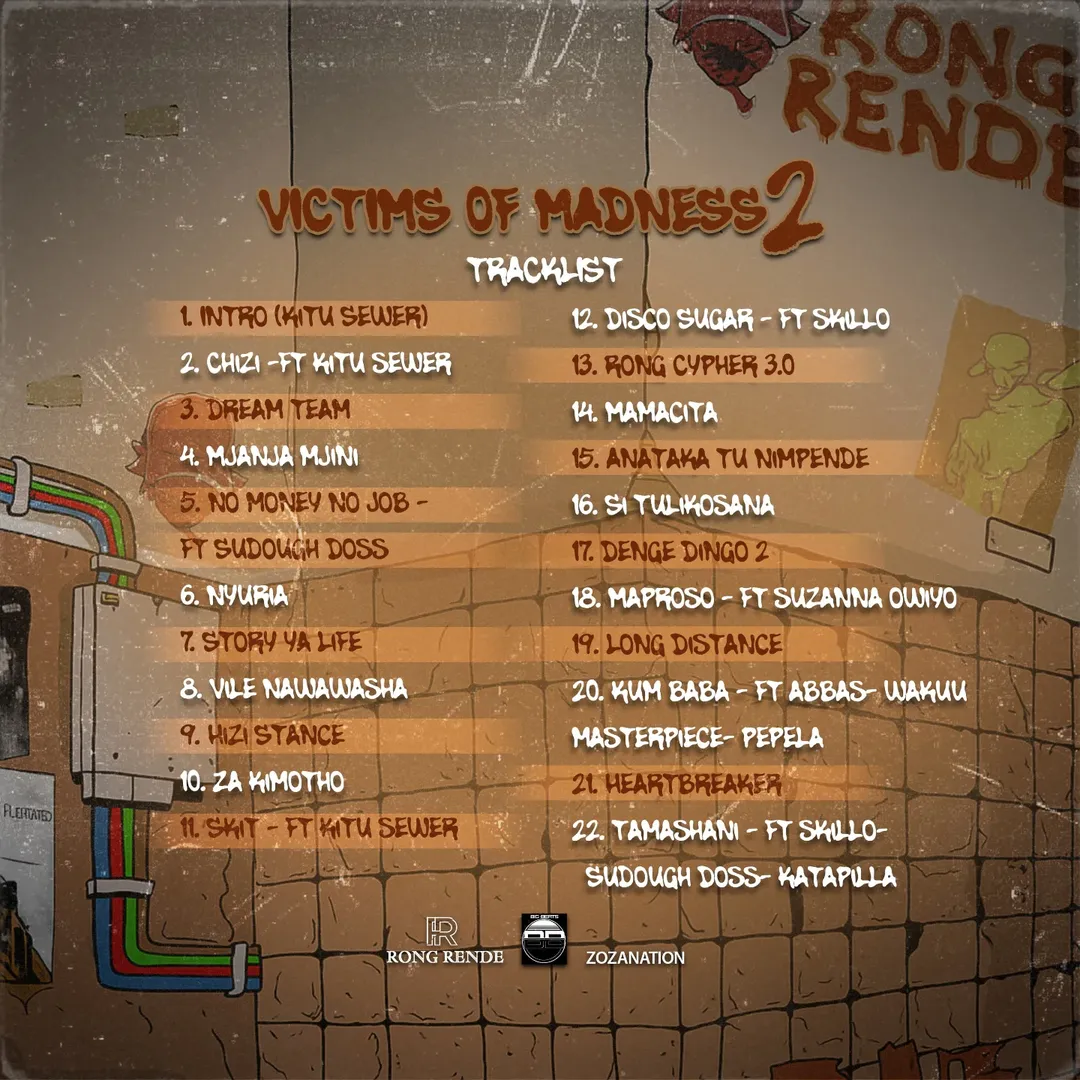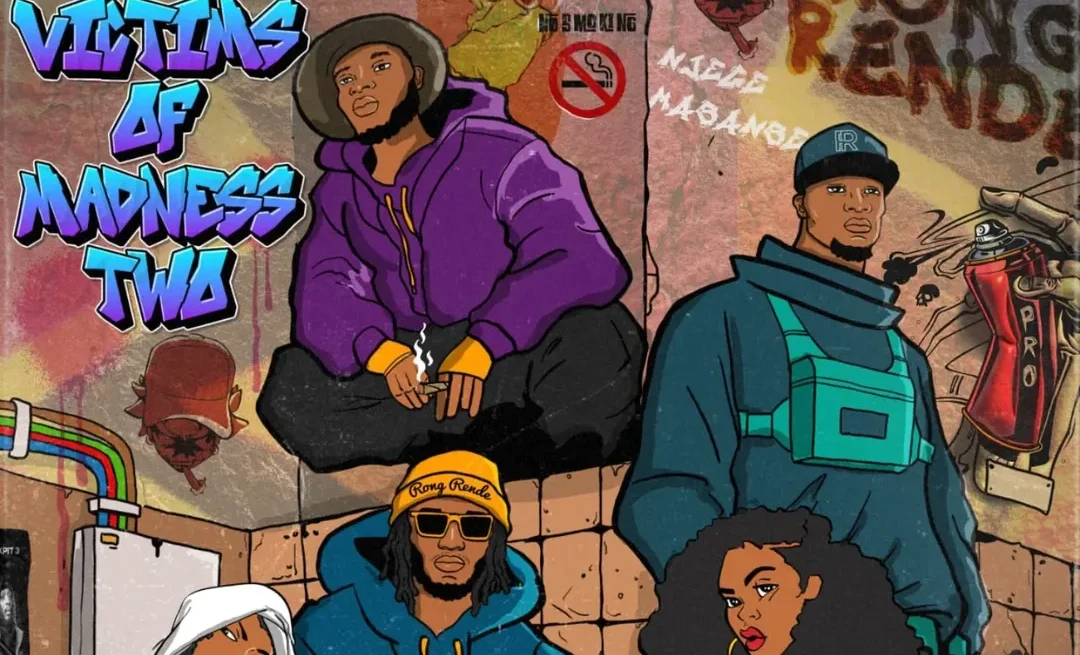While each Wakadinali artiste performs within their domain of expertise, the absence of aesthetic progression or new risks positions Victims of Madness 2.0 as a recursive engagement with what is already familiar.
By Frank Njugi
In art, proficiency is the ultimate currency. Sometimes, ascent defies conventional trajectories, for when craft reaches a certain level of mastery, recognition becomes not a matter of if, but when. Regardless of origin or access, the force of well-honed expression ultimately demands a platform. And Kenya’s HipHop trio Wakadinali’s journey may be the clearest indication yet that excellence, wherever it is forged, inevitably finds its audience.
No other rise in Kenyan pop culture mirrors the meteoric ascent of Wakadinali. The trio: Domani Munga, Scar Mkadinali, and Sewer Sydaa, emerged from the gritty underground of Eastlands to claim a central position in the country’s mainstream music scene at the close of the 2010s and the dawn of the 2020s.
Singles like “Morio Anzenza”, “Triple XL”, and “Avoid These People” marked their transition, capturing both the raw urgency of their origins and the refined aggression that would come to define a new wave in Kenyan hip-hop.
The singles were part of their 2020 album Victims of Madness, a project whose tracks embraced modern drill music’s signature traits: dark, hard-hitting, fast-paced beats and a lyrical focus on the perilous realities of inner city life.
Perhaps only a few notable modern projects from Kenya can claim to capture the essence of a people, a subculture, and their collective consciousness—and how that consciousness shapes their lived realities—as powerfully as Victims of Madness. Kitu Sewer’s Makali Man (released through Wakadinali’s recording outfit, Rong Rende) and Buruklyn Boyz’s East Mpaka London are among the rare works that come to mind in the same breath.
It’s been five years since Victims of Madness was released, and Wakadinali remains as talented and compelling as ever: a fact clearly reflected in their subsequent projects. Sewer Sydaa continues to stand out as the prime lyricist and poet, Domani Munga remains the master of melody and flow, and Scar Mkadinali has solidified his role as the hitmaker and the group’s ambassador—branching out through collaborations and pushing the Wakadinali sound to broader audiences. And perhaps as a fitting marker of that five-year milestone, the trio recently unveiled the second installment of the album, Victims of Madness 2.0.

This new project has a tracklisting of 22 songs, which are compositions that breathe the same air as Victims of Madness, exude comparable energy, and engage with similar themes. Yet, on in-depth engagement with the songs, one notices that Victims of Madness 2.0 might inevitably be overshadowed by a predecessor that represented a seismic release in the nation’s musical consciousness.
This is largely due to the fact that the singles, while sonically polished and structurally sound, register more as stylistic reiterations than departures. Sewersydaa sustains his established mode of politically charged lyricism, accessible and narrative-driven bars; Domani once again leans into his strength for melodic hooks; and Scar reprises his role as the charismatic, energetic presence.
While each Wakadinali artiste performs within their domain of expertise, the absence of aesthetic progression or new risks ultimately positions Victims of Madness 2.0 as a recursive engagement with what is already familiar.
There is a genius to how they begin the album: with a spoken word narration performed by Kitu Sewer—an intentional invocation of Hip-Hop’s griotic tradition, perhaps. This choice is later echoed in an interlude simply titled “Skit”, where the veteran emcee re-emerges as a structuring presence. The transition from the spoken word-inflected opening to the second song “Chizi”, comes with precision, as the featured rapper’s verse brings the balance between accessibility and intellectual rigor to the verses by the trio as well.
“Dream Team” functions as a lyrical invocation of supremacy, the assertion of being the best in the game. Bravado-laden verses are posturing, delivered with the technical prowess that has long characterised Wakadinali’s catalogue. The subsequent track, “Mjanja Mjini”, captures the group at its most entertaining and sonically infectious: Domani’s hypnotically repetitive chorus (Mjanja wa Mjini) sets a rhythmic foundation that feels almost incantatory, while Scar Mkadinali and Sewersydaa leap in with complementary energies; Scar delivering prideful, hard-edged bars, and Sewersydaa weaving poetic flair into the track’s fabric. Together, they complete a tripartite flow, like three perfectly aligned sides of an angular, streetwise puzzle — each distinct, yet essential to the whole.
On “Nyuria” and “Vile Nawawasha”, it is Sewersydaa who emerges most distinctly, returning to the narrative-rich style that has long defined his imprint. Both tracks lean heavily into storytelling, providing the ideal terrain for his lyricism to shine, and his verses become the gravitational center of each. Notably, “Vile Nawawasha” carries with it a veiled diss at Kenyan veteran artiste, Nyashinski, though its potential impact is diluted by the absence of a full lyrical follow-through, which leaves the provocation unresolved.
“Story Ya Life” stands out as a near-magical moment on the album. Domani delivers what is arguably the most sonically compelling chorus on the entire project, which is seductive in its cadence and emotive in tone. Here, all three members meet at a shared peak in delivery, achieving a rare equilibrium. The dexterity displayed on this track, alongside the vibrancy of “Mjanja Mjini”, momentarily suggests the trio’s capacity to elevate the album beyond the expectations set by its 2020 predecessor, Victims of Madness.
However, that promise is undercut by noticeable dips in lyrical depth and thematic ambition across other tracks. Like “Disco Sugar”, featuring Skillo, which comes as an uncritical glorification of hedonism, with its preoccupation with drugs and excess. Similarly, “Anataka Tu Nimpende” initially postures as a love song, but quickly reveals itself as a conflation of sex with affection and intimacy reduced to physicality.

But there also appears to be a deliberate curatorial choice to include several of Wakadinali’s more recent hit singles in Victims of Madness 2.0. “Maproso”, released in September 2024, stands out as a cultural bridge, merging Kenya’s musical past with its present. Featuring veteran songstress, Suzanna Owiyo, the track opens with a looping guitar riff and traditional Benga rhythms that signal an intentional nod to East African sonic heritage.
Another highlight, “Tamashani”, released in early 2025, brings together guest verses from Skillo, Sudough Doss, and Katapilla, creating a spirited posse cut that brims with collective energy. Meanwhile, “Hizi Stance” and “Heartbreaker” inject a dose of infectious dance-floor vibrancy into the project. These tracks, unapologetically fun and rhythm-driven, provide moments of levity. The inclusion of these recent hits adds both momentum and range to the album’s arc.
“Za Kimotho” channels a similar energy to “Story Ya Life”—with Domani once again anchoring the track through a sonically compelling chorus. The track, already gaining rapid traction online and poised to hit a million views on YouTube, signals the potential emergence of yet another standout hit single from the project and Wakadinali.
“Mamacita”, a love-leaning track, distinguishes itself through its lush production. While lyrically it may not carry the same weight as other offerings, its sonic palette is really polished. However, to isolate “Mamacita” for critique in comparison with other tracks would risk missing the forest for the trees; what’s most striking about Victims of Madness 2.0 is how sonically assured the project is as a whole even when lyrical content varies in depth.
“Si Tulikosana” follows in a similar vein as an amusing, mid-tempo narration of heartbreak and the cyclical absurdities of modern relationships. “Long Distance” travels a parallel path, though with a more raw and energetic execution. Driven by a faster tempo and a beat that leans into the playful urgency, the track invokes the chaotic rhythms of Nairobi’s urban love culture, being whimsical in tone and with a sharp observational wit.
“Denge Dingo 2”, on the other hand, reimagines “Denge Dingo”, a Domani Munga single released just a month prior, that featured one of the best fast-rising East African rapper, 4mr Frank White. While Domani retains the thematic core, the inclusion of Sewersydaa and Scar Mkadinali in place of 4mr Frank White and Toxic Lylikali introduces an entirely new dynamic.
It would be disingenuous to draw a one-to-one comparison between the two iterations, as where the original leaned heavily on the raw hunger and underground energy of East Africa’s next wave, the second version highlights the group’s ability to recontextualize a track’s essence through collective chemistry.
“No Money, No Job” epitomises what Wakadinali has long represented: raw, unfiltered reflections on inner-city economic precarity, joblessness, and the everyday grind of survival. It features Sudough Doss, who arguably delivers the most potent guest verse on the entire album.
“Rong Cypher 3.0” plays like a stripped-down iteration of Wakadinali’s earlier collaborative high points. While it retains the aggressive, bar-heavy essence of its predecessors, it feels more like a reassertion than a reinvention. In the trilogy of Rong Cypher tracks, it falls short of the ambitious second installment, which featured a wider array of guest artistes. Still, it maintains the lyrical sparring and crew chemistry, foundational to their cypher tradition.

“Kum Baba”, on the other hand, with its dancehall-inflected rhythm and bounce, leans closer to the vibrancy of “Rong Cypher 2.0”. It brings back the energy of that second rendition, bolstered by featured artistes who drop infectious, earworm-worthy hooks and verses.
Victims of Madness is not Wakadinali’s only serial project. Their discography also includes three iterations of Ndani Ya Cockpit. This is a trilogy where progression and identity evolution are evident with each successive release. In contrast, Victims of Madness may seem stagnant; yet, it does not signal regression. If anything, its consistency is a testament to the group’s mastery of a sonic terrain, which is something they might rightly take pride in.
When artistic acts are already operating at the apex, maintaining that standard, even without venturing into uncharted territory, can be a feat in itself. The trade-off, however, is that the lack of novelty risks audience fatigue, as this is a challenge that looms over any artistes who choose refinement over reinvention.
Lyricism – 1.0
Tracklisting – 1.2
Sound Engineering – 1.6
Vocalisation – 1.3
Listening Experience – 1.3
Rating – 6.4/10
Frank Njugi is an Award-winning Kenyan Writer, Culture journalist and Critic who has written on the East African and African culture scene for platforms such as Debunk Media, Republic Journal, Sinema Focus, Culture Africa, Drummr Africa, The Elephant, Wakilisha Africa, The Moveee, Africa in Dialogue, Afrocritik and others. He tweets as @franknjugi.




